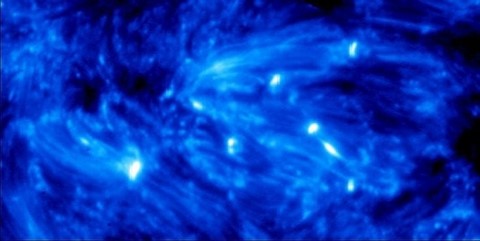Hot explosions, cool Sun
The Sun turns out to be more unpredictable and mercurial then we thought. Besides solar eruptions – powerful eruptions of particles and radiation in the Sun's outer atmosphere – there also occur mighty explosions in the cooler layer beneath: in many places, magnetic energy accumulates and discharges within a few minutes in heat-eruptions of up to 100,000 degrees Celsius. Proof for these short-lived nests of heat was found for the first time by researchers under leadership of the Max-Planck-Institute for Solar System Research in Göttingen (Germany) in data from the American space telescope IRIS.

Broiling star: on this picture of the Sun's photosphere, taken by the space telescope IRIS at the end of September 2013, one can see the explosions as light colored spots. The picture shows a region of a surface 50,000 times 25,000 Kilometers.
There's hot, and then there's hot – at least, when one is considering the Sun. It is true that in all of the onion-like layers which constitute our Star, there are reigning almost unimaginably high temperatures, but some are considerably higher than the others. With ca 5,000 degrees Celsius, the visible surface of the Sun, the photosphere, is relatively cool. As one goes farther out, the temperatures diminish lightly and then, in the Sun's atmosphere, they increase moderately at first and then shoot up extremely fast to temperatures of about a million degrees.
„Our analyses show now that this gradation of temperature is not the same everywhere, and moreover it is in constant motion,“ according to Hardi Peter of the Max-Planck-Institute for Solar System Research, main author of the study which appeared in the magazine Science. „In small, circumscribed regions from all appearances, and for short periods of time, dramatically higher temperatures can occur even in the cool outer layer of the photosphere. “
Together with an international team, Peter has analyzed data from active regions of Suns transmitted by the Space telescope IRIS (Interface Region Imaging Spectrograph). These areas of the photosphere show high magnetic field values and are the birthplaces of the sunspots, which appear in varying numbers and sizes over time at the surface of the Sun.
„In these areas we are finding pockets of heat about half the size of Germany which are 20 times hotter than their immediate surroundings,“ Peter says. They light up only for the space of a few minutes, and then they return to normal temperature. The amount of energy released by one of them would suffice to supply Germany with electricity for 8,000 years."
These powerful explosions in the photosphere are not distinguishable in the visible light, yet they leave traces in the ultra-violet radiation which the Sun is sending into space. IRIS is able to dissect more precisely than any other observatory before it ultra-violet radiation in its component wave lengths. And this in a heretofore unatteignable spatial resolution: the space telescope, which put its sight onto the Sun for the first time in July 2013, renders structures of a size of only 250 Kilometers visible and is able to analyze separately the radiation emitted by such small areas.
„To our great astonishment, we found in the active areas clearly defined regions the radiation from which differs for a short time, in significant features, enormously from their environment „ according to Hardi Peter. The researchers were able to make out some characteristic wave lengths which are shooting into space some highly ionized atoms of the solar plasma – for instance triple ionized silicium.
„Alreay the existence of such wavelengths in the spectrum points at extremely high temperatures,“ says Peter. For it is only under such conditions that Silicium can lose all at once three of its electrons. Yet in what layer of the Sun have such temperatures been reached? In the cool photosphere itself? Or – and this would be considerably less spectacular – farther out, in the much hotter atmosphere of the Sun?
The spectrum data from IRIS proved so detailed that the scientists were able to ecke out of them further decisive information. So that for instance they have evaluated the thickness of the solar plasma at the spot where the radiation originated, and proven that the radiation, on its way through the farther outside layers of sun had simply encountered ionized iron ions. Which occur only in cooler regions. „All in all, a coherent picture started to emerge: the remarkable radiation must have originated in the cool outer part oft he photosphere,“ according to Peter.
The scientists surmise that the strong magnetic fields in the photosphere provide the necessary energy for the heat explosions. In the areas of sunspots, magnetic field lines rise in arched shapes out of the Sun’s surface; hot plasma shoots through these arches. If there occurs some kind of short-circuit within these flows, explosions occur.
„The new results have changed our image of the outer constitution of the Sun from the ground up,” says the Max-Planck scientist. “Instead of a stable temperature layering, there occur in the photosphere, from all apperances, dynamic processes which send everything upside down for short periods.”
In 1917 already, the American physicist Ferdinand Ellermann had discovered areas in the photosphere with more elevated temperatures. But they varied only by several thousand degrees from their surroundings, which would represent only a relatively small temperature change. It is not yet clear if the newly discovered explosions represent the same phenomenon.
Another publication in Science, to which the scientists oft he Max-Planck-Institute for Solar System Research have contributed recently, throws a new light on the processes occurring on the Sun. Under the direction of the Harvard-Smithsonian Center for Astrophysics, experts discovered – also from IRIS data – that the solar wind, a continuous flow of solar particles, does not leave the surface of the Sun evenly, but in some places in highly energetic, localized streams.
Translated from the German by Anne-Marie de Grazia

